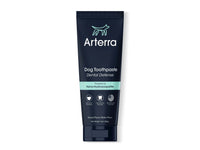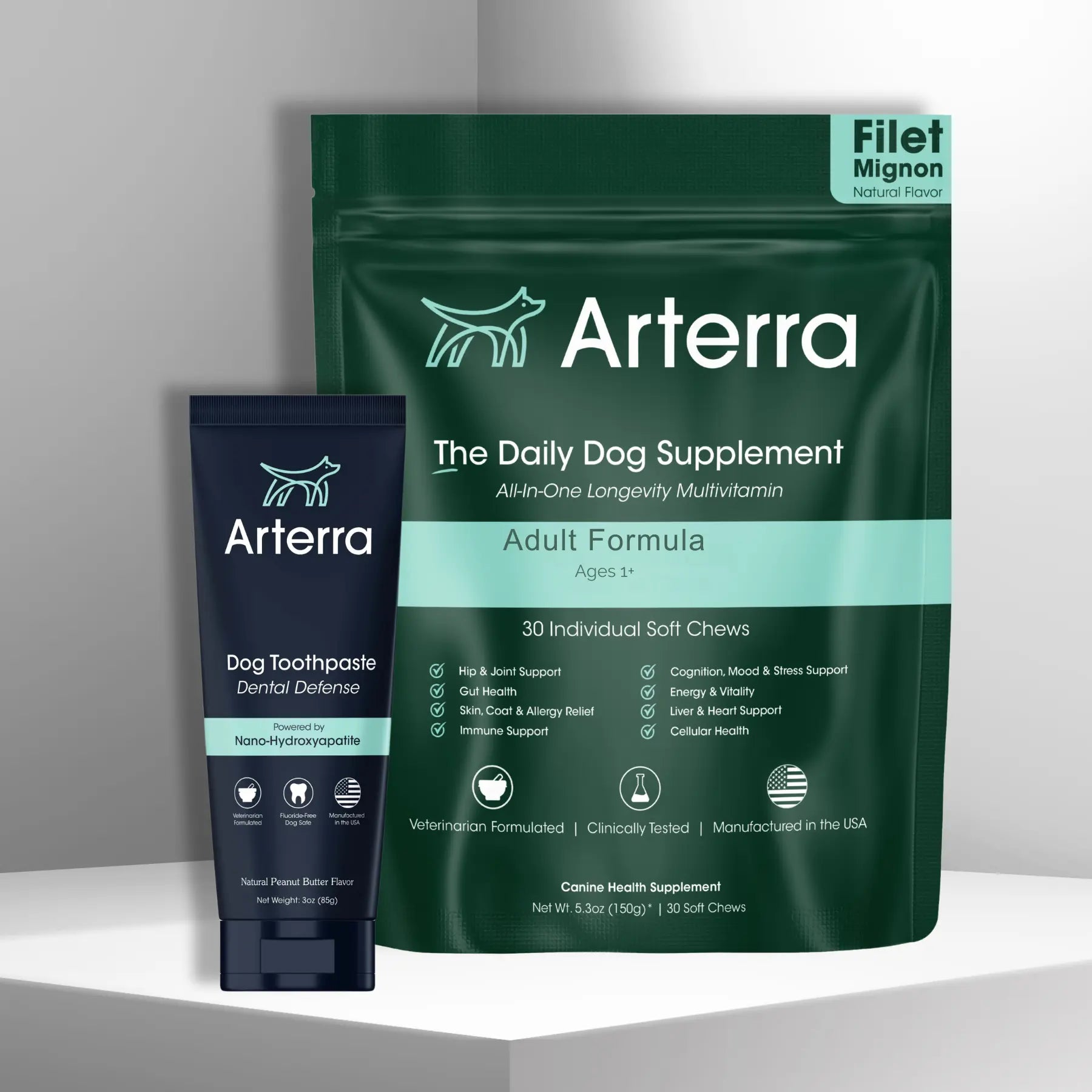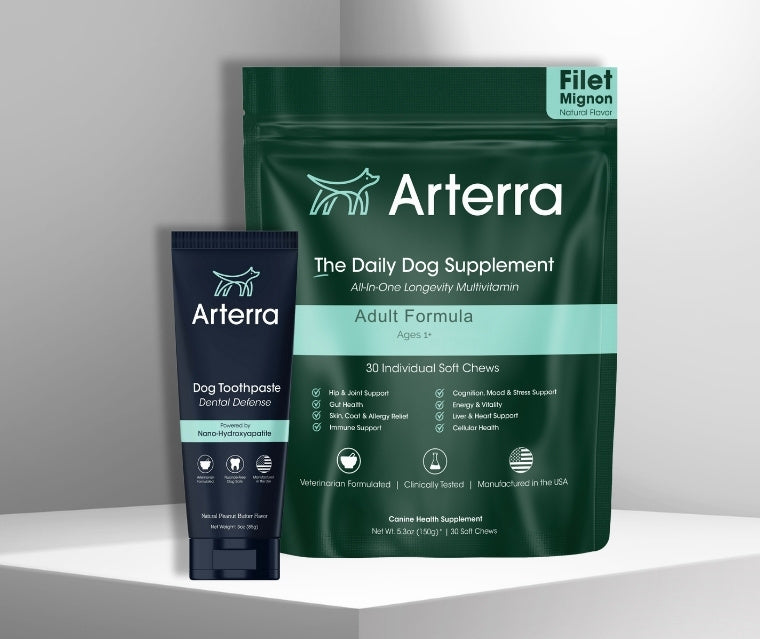2024 is poised for an explosion of consumer and investor interest in the burgeoning canine longevity space. I believe that Arterra, together with two other companies, Loyal and Leap Years, currently represent the three most compelling approaches to extend and enhance canine lifespan.
As a passionate dog lover and advocate for healthier canine aging, I’m first and foremost excited that, for the first time, our space has three quality companies pursuing distinct paths in support of this mission, and that all of us – in my humble opinion – are doing good work.
Last month I addressed in detail how Arterra’s whole-body approach to canine wellness compares and contrasts to Loyal’s pharmaceutical path. Today, I’d like to deep dive into how our products compare to Leap Years’.
Leap Year’s Approach
Leap Year’s products are comprised of just two active ingredients, LY-D2, an NAD+ precursor, and LY-D6, a flavonoid compound that acts as a senolytic agent. Because their ingredients are patented, we don’t have full transparency into exactly what they are, but their patent application gives several clues. Without going down a very deep rabbit hole that I suspect would make most readers’ eyes glaze over, let’s accept their own high-level summary of their two compounds. Their approach is twofold:
Boost NAD+ levels to increase cellular energy production, which drives a downstream host of benefits in areas such as cognition, energy/vitality, cardiovascular health, and regulating inflammation.
Support the clearance of senescent (old and dysfunctional) cells via a senolytic flavonoid compound.
These are two powerful strategies that I would expect to produce a range of healthspan-promoting benefits. To Leap Years’ strong credit, they’ve nearly finished validating these benefits with a clinical study due this spring (Arterra’s will follow a few months behind, this fall).
My review, in short, is that they have an excellent product that likely works as advertised. But I also believe that it’s very expensive for what it is, and that Arterra’s products represent not only a superior and more comprehensive approach to healthy canine aging, but also a better value for the money. I’ll explain why.
Arterra’s Approach
As a starting point, I think it’s important to establish that our formulas — similarly to Leap Years — also contain senolytic polyphenols and flavanoids (notably quercetin, resveratrol, trans-pterostilbene, turmeric, and green tea-derived catechins). Further, assuming a dog is consuming a nutritionally complete diet with adequate sources of Vitamin B3 and the amino acid tryptophan, our flavanoids also support the conversion of these precursor molecules into metabolically active NAD+. So in a meaningful way, both Arterra and Leap Years provide overlapping benefits for these two dimensions of aging.
With this said, our approach to healthy aging is much broader and more aggressive than theirs. We believe that the body is an astonishingly complex system, and that modern science has not yet discovered any one or two “silver bullets” capable of supporting healthy aging alone. But what we do have is a pharmacopeia of dozens of well-studied, naturally occurring molecules that individually help chip away at the problem of aging through multiple strategies, vectors, and pathways, and which together produce an entourage effect greater than the sum of their parts.
To this end, Arterra’s flagship Adult and Senior formulas are comprised of 46 and 63 science-backed ingredients spanning eight functional domains, each supported through multiple pathways. These are:
Longevity – Focused on epigenetic activation of the SIRT1 and AMPK pathways, mitochondrial health, reducing formation of advanced glycation end products (AGEs), and senolytic agents to help the body clear senescent cells. Check out our blog posts for deeper dives into these topics.
Joint Support and Comfort – Supporting the underlying structural health of the joints through high doses of collagen, including bone broth-derived Type II Collagen, by promoting hydration within the joints, reducing inflammation, supporting tendon and ligament strength and recovery, and reducing discomfort from age-related degeneration of cartilage.
Cognition and Mood – Supporting in parallel the underlying health of the brain by increasing BDNF, NGF, synaptic density, and circulation, while increasing the availability of neurotransmitters involved in positive mood, energy, and motivation.
Organ Support – Supporting the healthy function of the liver, heart, and vascular system.
Immune support – A multi-pronged approach to a healthy immune system, with target benefits ranging from relief of occasional seasonal allergies to preventative support for more serious immune-related conditions.
Gut Health – Formulated first to improve the integrity of the gut and intestinal lining (aka “leaky gut” support – a widespread issue for dogs fed a standard American kibble diet), with additional pre- and pro-biotic support for a healthy microbiome.
Healthy Stress Response – A potent blend of adaptogenic herbs and mushrooms to help the body cope with environmental and physical stress through increased stamina and recovery, and decreased production of cortisol (a damaging stress hormone when overexpressed).
Antioxidant Support – To reduce oxidative stress in synergistic harmony with the rest of our formula.
For a deeper dive into our complete formula, check out the Ingredient Explorer on our product page.
Any one of these systems can be a critical point of failure for a dog’s longevity or quality of life, which is why we’ve carefully designed our formula to support all of them in harmony. We’ve further formulated with a philosophical eye toward what I like to call “hardware,” and “software” support, with the former class of ingredients supporting the structures, building blocks, and resilience of a given system, and the latter supporting its metabolic programming via epigenetic modulation, cell metabolism, and other factors.
Together, I believe Arterra’s approach represents the most comprehensive, powerful, and efficacious canine supplement ever brought to market.
Arterra vs. Leap Years
Let’s first bump the two overlapping areas of our formula head-to-head – as a senolytic, and as an NAD+ booster.
Based on the information that can be gleaned from Leap Years’ patent, as a senolytic stack I would expect the performance of our formula to be roughly in line with theirs. In good faith, I would call this measure a tie.
However, as an NAD+ booster, specifically, their product is almost certainly superior, though ours does still provide notable coverage here. So on this one metric, they win.
But I believe strongly that Leap Years’ one likely advantage in NAD+ promotion is vastly offset and surpassed by our multi-pronged approach to whole-body anti-aging. In fact, we looked heavily at this exact question when developing our formula with our veterinary partners. We carefully explored including NAD+ precursors such as NMN, NR, or NADH, but found that the cost of including this one great ingredient was so expensive that we could literally include 20 other very good ones for the same price. When confronted with this tradeoff, I made the mission-driven decision to take this deal and opt for breadth. And given the unparalleled scope of benefit coverage this tradeoff empowered – unmatched by Leap Years or any other competitor – I maintain that it was a good one.
Finally, a fair comparison of our two products must consider price. Both Arterra and Leap Years’ products are expensive relative to legacy pet supplement brands, and necessarily so due to the cost of our premium ingredients.
Leap Years’ pricing ranges from $31/month for small dogs to $117/month for extra-large breeds. This puts their pricing roughly in line with our 46-ingredient Adult Formula (which can also be given to seniors), which starts at $25/month for small dogs and rises to $99 for large breeds.
Given Arterra’s vastly broader range of functional benefits over Leap Years’, and considering the overlapping coverage of broad senolytic support between the two products, as well as Arterra’s (admittedly weaker, but still noteworthy) NAD+ support, I believe our Adult Formula represents a dramatically superior value for the money – one that I strongly expect will drive more powerful and observable improvements in quality of life.
Taking the comparison a step further, Arterra’s more expensive flagship 63-ingredient Senior Formula dials up the volume on everything in our preventative Adult Formula, while adding an additional class of ingredients focused specifically on quality-of-life improvements for older dogs already experiencing the consequences of degenerative aging. These ingredients were selected to help your older dog feel more comfortable in their aging body and mind. I am deeply proud of this product, and believe that — beyond a quality diet —it is today the single most powerful intervention for healthy canine aging available on the market at any price.
Our Senior Formula is, however, quite expensive, ranging from $50/month for small dogs up to $160/month for large breeds. In this regard it is indeed a modst step up in price from Leap Years’ product, but also in breadth and, I believe, efficacy.
Our confidence in the ability of both Arterra formulas to drive obvious results is so strong that we back them with a 100% moneyback guarantee. If you can’t see a positive change in your dog within 30 days, we’ll refund your purchase price without hassle. This is notably a guarantee that Leap Years does not offer. And since our launch three months ago, less than 2% of our customers have taken us up on it, which tells us (and hopefully you too) a lot about the performance of what we’ve created.
In summary, I believe that Leap Years has launched an excellent product, but that our Adult Formula is a better and more effective value for the money. And for those wanting to max out what’s possible within the natural pharmacopeia for their older dogs, our Senior Formula offers an even more powerful solution that’s unrivaled on the market at any price.
Our clinical study is underway and won’t be completed until this fall, so until the results are published I’ll have to ask you to take my word on good faith. But I hope that for the interim, I’ve done a thorough and fair job of substantiating why I believe this to be the case.
I respect Leap Years and believe their team is smart, thoughtful, and sincere. I also believe the market for healthy canine aging is in its infancy and poised for explosive growth, and that there’s plenty of room for both brands to thrive commercially while delivering on our missions. And so it’s in the spirit of transparency, consumer education, and healthy competition that I’ve made this comparison between our products.
If anyone in the community believes I’ve been unfair in my analysis, inaccurate in my science, or otherwise missed something important, don’t hesitate to reach me directly at jonathan@arterrapet.com.
Jonathan Willbanks
Founder & CEO
Arterra Pet Science






